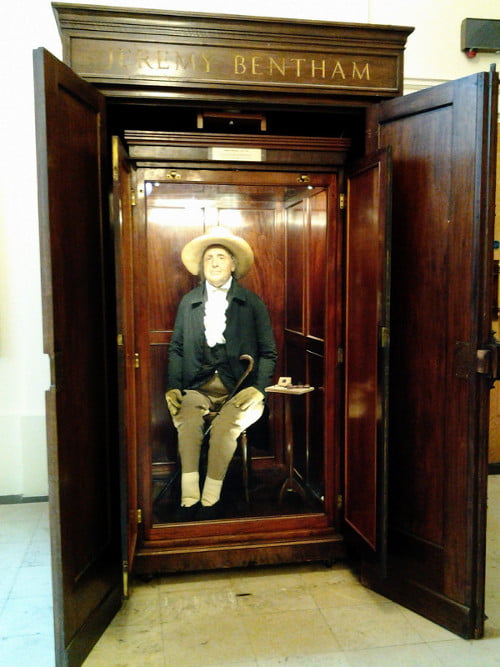
When people die, what happens to their remains? Some are buried. Some are cremated. And some have their bodies put on display in universities.
Wait, let’s back up a little bit.
Before he died, the British philosopher Jeremy Bentham (1748-1832) wrote a will that he titled Auto-Icon: or, Farther uses of the dead to the living. It provided instructions for what should become of his body after his death.
In short, he requested that parts of it be preserved and put on display as what he called an “Auto-Icon.” As he wrote in his will on May 30, 1832:
“My body I give to my dear friend Doctor Southwood Smith to be disposed of in a manner hereinafter mentioned, and I direct (that) he will take my body under his charge and take the requisite and appropriate measures for the disposal and preservation of the several parts of my bodily frame in the manner expressed in the paper annexed to this my Will and at the top of which I have written Auto Icon.”
And so it was. After his death in 1832, Bentham’s skeleton (after dissection, of course) was preserved by his friend and disciple Dr. Southwood Smith. Smith fitted the skeleton with an old black suit that Bentham used to wear and stuffed it with hay.
He then placed it onto Bentham’s favorite chair inside what is essentially a wooden cabinet, completing the so-called Auto-Icon. All of this was perfectly according to the details contained in Bentham’s will.

Bentham’s head, however, was a different story. Dr. Smith attempted to mummify (well, desiccate) Bentham’s head using the method of the indigenous New Zealand Māori, but the process didn’t quite go as planned.
The head wound up looking blackened and expressionless. Macabre, you could say. Grim.
A wax head was used in its place, and for a while the real one could be found seated between the Auto-Icon’s feet, harboring the glass eyes that Bentham used to carry with him when he was alive (he was very excited about his Auto-Icon, you see).
The Strange History of Jeremy Bentham’s Head
In 1850, the Auto-Icon was acquired by the University College London, where it can be found today. Bentham is more or less considered a “spiritual founder” of the university, according to Wikipedia, so it’s fitting that he wound up there.
But that strangely desiccated head became somewhat of an issue. For a while, it just sat there, exposed to the world. Later, it was placed in a wooden box on top of the Auto-Icon for better protection.
And then, after being temporarily stolen by students from King’s College London (and later allegedly used for football practice), it was locked away. According to the UCL Bentham Project, it now resides in the Conservation Safe in the Institute of Archaeology.
While the head is nowadays off-limits to the public (they decided that, uh, human remains aren’t “appropriate” for public display), the rest of the Auto-Icon is ever present.






